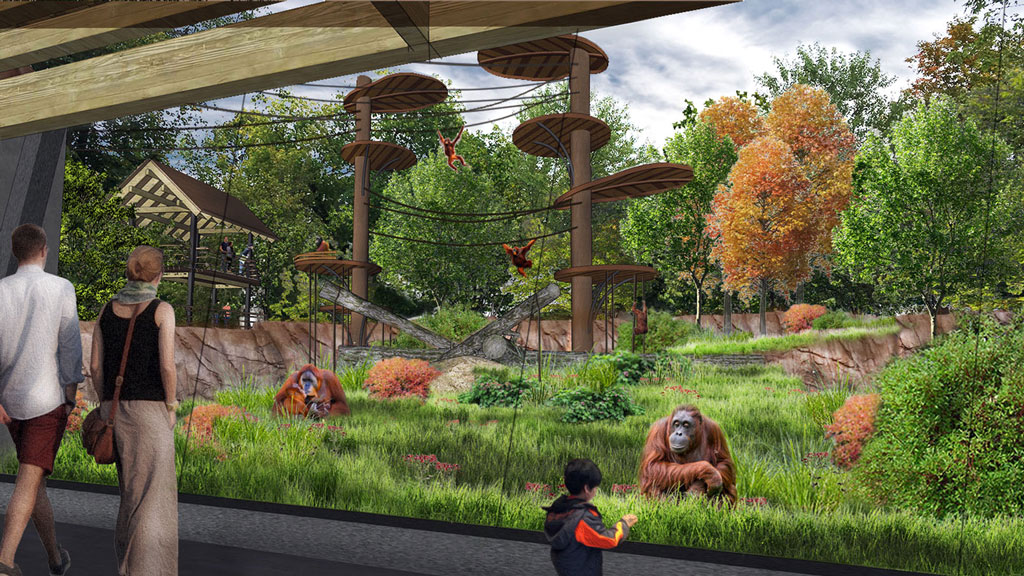National and provincial building codes do not include clauses dealing with orangutan climbing poles which highlights one of the many design and planning complexities of a new $9.9 million orangutan exhibit at the Toronto Zoo.
Construction by general contractor Midome Construction started in July on this project with an extensive steel component.
Designed by Zeidler Architecture Inc. in association with Jones & Jones Architects & Landscape Architects Ltd, a firm with a specialty in zoo design, the exhibit will include two outdoor habitats housing a total of eight cantilevered HSS steel poles with three 25-mm-thick steel cables extending from pole to pole for orangutans to walk/climb over the zoo visitors.
There will also be slight modification to the indoor existing Orangutan holding/exhibit areas within the zoo’s Indo-Malaya Pavilion
The Orangutan Outdoor Exhibit will be a modern facility that provides outdoor access that has never before been available before to the zoo’s six resident orangutans, says zoo project manager Ben Knoop.
“Orangutans are arboreal or tree dwelling creatures” says Knoop, explaining that, in this setting, the steel poles will be the trees.
There are also primarily solitary animals that don’t live in large groups — which is the reason Habitat One will have two separate spaces, allowing the orangutans to comfortably distance themselves, while seeing the others. To maintain that social distance, not all the poles will be climbing ones, but there will be resting/landing spots allowing them to return from where they started, he says.
Orangutans have been at the Toronto Zoo since it opened in 1974. At that time, the exhibit was considered state-of-the-art. Since then a lot has been learned about them including their need to climb higher and experience the outdoors, says Knoop, in explaining the rationale for the exhibit.
A considerable amount of research and input from the various partners including the Zoo’s animal experts was invested into the project. After an initial brainstorming session, it took approximately six months to refine initial concepts to the point that detailed design could commence with the whole process taking about a year, says Knoop.
“There aren’t any Ontario Building Code (OBC) requirements to determine how much load to put on a cable structure supporting an orangutan,” says Nathan Bissell, a project engineer with RJC Engineers in underlining the structural design issues that had to be resolved.
“Nor are there any OBC deflection requirements for the sag in the cable, or the deflection at the top of the poles supporting the cable.”
To determine the loading requirements, RJC relied on the Toronto Zoo management to provide answers on the orangutans’ weight and how many could be allowed on the cables at any one time.
“We designed the cables to support the most critical scenario of a male, female, and baby orangutan being on the cable at the same time — approximately 250 kilograms maximum.”
Then it was case of using engineering judgement to determine maximum cable sag and pole deflection, says Bissell, admitting there was lot of “gut feeling” involved.
While the cables have to deflect somewhat, it was critical to maintain a 10.7-metre-height distance from spectators who will be watching the orangutans. As there won’t be any netting, the height distance is intended to protect both humans and orangutans, who might be tempted to jump on to trees or other objects.
“They’re intelligent enough to know not to jump from such a height.”
To be supported on 850mm diameter by 50mm thick stiffened base plates, the six poles to be erected in Habitat One will have a height of 13 metres, with 610mm diameters and 59.5mm thick walls. Reaching a height of 20 metres, the two poles slated for Habitat Two will have 915mm diameters with 25mm thick walls and will be supported on 1170 diameter x 50mm thick stiffened base plates, says Bissell.
Most of the poles will be on single caissons, but a caisson and bridge plate system will have to be used for one in area of unstable slope stabilization, he points out.
There are other interesting steel elements as well, including a mesh-clad chute or bridge which permit the orangutans to walk from the interior pavilion to Habitat Two and back again. A similar, smaller chute will be built at the opposite end of the pavilion allowing the orangutans to enter Habitat One, says Bissell.
In addition to loading and sag calculations, another issue that had to be resolved before construction could proceed was how the poles would be manufactured and which firm would do. An Alberta firm was eventually obtained.
“This is not something you call your local fabricator for,” says Bissell.
Besides the climbing poles, the exhibit will have other features including a small research/observatory station, as well as interpretive panels to provide a “fun but educational experience for visitors,” says Knoop, the Zoo project manager.
Because of the destruction of the rainforests in Indonesia through human activity, such as the creation of palm plantations, orangutans are a critically endangered species. One of the messages the Zoo intends to promote is the need for consumers to purchase only sustainable-sourced palm oil, says Knoop.
Construction of the exhibit will be completed sometime in 2021, but an opening date hasn’t been determined, he says.









Recent Comments
comments for this post are closed